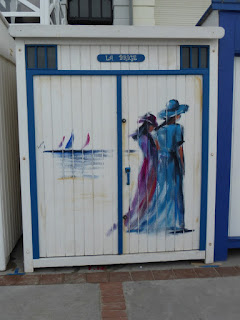Our drive back to Amsterdam Friday was made memorable by the heat, our desire not to get caught up in the Calais/Dunkirk ferry strike traffic, and by our navigatrix' having ticked the "no expressways" box on our satnav and forgetting this days before. We thus wandered the back roads of northeastern France and west Flanders for some hours, passing over numerous freeways, but never entering. The error was discovered somewhere in the vicinity of Ieper (Ypres), but it was over-corrected, permitting toll roads, and putting us on the southside Antwerp Ring road with it's stunning 19E toll. (RVs get counted like 18-wheelers; it's a height issue, not just length or number of axles). Anyhow, we got to Amsterdam in good enough order and parked for the night at BW Campers.
Saturday morning Rene and his colleague Richard were there to work on our ailing fridge. The repair, such as it was, took two experienced men three hours to do. The crux was moving the fridge enough to permit access to the burner and gas jet. The clown who designed our camper put the access hatch about six inches too high. Otherwise it would have been a straightforward half hour, removing the burner, cleaning out the jet, and reinstalling. We stayed that night at Amsterdamse Bos, again, doing the wash, etc., and testing the propane/fridge repair. All seemed well by Sunday morning, so with the fridge re-provisioned, clothes clean, and all tanks relevantly filled or emptied, we set forth again for
France to resume our travels.
There was a surprising amount of traffic for Sunday morning, despite the fact that trucks aren't allowed on the roads on Sundays in Netherlands. (Or in France; or other civilized places). We hit rain near toll-free Antwerp and resolved to stop early and see Ieper the next day. Where to stop was easily answered, since St. Sixtus' Abbey is only a dozen miles from Ieper and we suspected the brothers would let us stay in their parking lot overnight, especially if we drank some of the holy hop water and visited the gift shoppe. We did, and they did. The place is incredibly busy on Sundays, and the parking lot didn't finally clear out until 10 (the restaurant closes at 8), but after that it was very quiet until the first bells Monday morning. We drove on to see Ieper that morning (next post), but then came back to St. Sixtus for a long and productive lunch. In addition to the best beer in all Creation, they also have very reasonably-priced locally-produced food, especially the cheeses and pates, and free wifi, in the restaurant/visitor center, In de Vriede. Life is good. We plan on becoming regulars. I think Vicki gets a kick out of the festive and authentic atmosphere, being with scores or hundreds of
knowing people who are happy to be in a very special and hard to find place.
 |
In Belgium and also a few in Netherlands, giant windmills than have been painted
shades of green at the bottom, as if to make them less conspicuous |
 |
This is how civilized people drive: somewhere around Rotterdam, about 2km ahead,
there has been an accident (a boat trailer turned over); the signs overhead advise
slowing to 50kph and moving to the left lane; as if rehearsed, all the Dutch drivers
do precisely this...merging "like a zipper" as the Kiwis say; no testosterone
confrontations about who takes precedence, as in Italy or France; no nasty gestures
nor gun-play nor bloodshed, as in the US; no one passing everyone else on the right
lane, which, as far as you can see, is open; everyone acts in the interest of the
common good.... |
 |
| The road to St. Sixtus' Abbey is straight and very narrow; and wet |
 |
| Staying over-night at St. Sixtus' Abbey |
 |
| Part of the Monday afternoon line to buy a six-pack of Westvleteren... |





































































